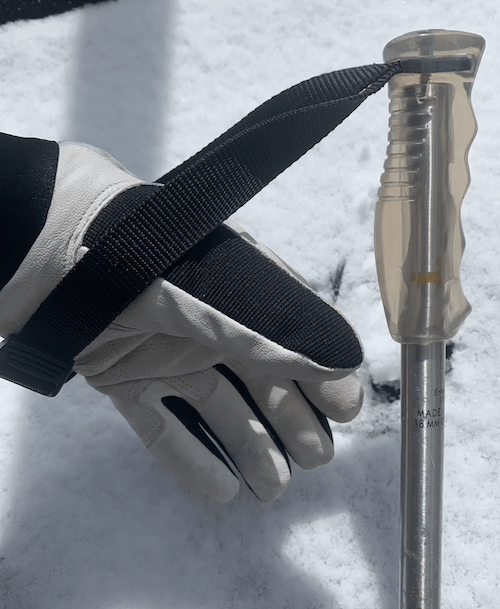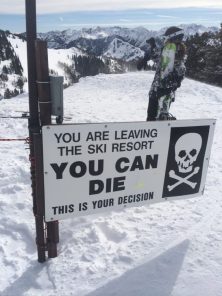A Sign of the Times
You’ve decided to take the family out for their first day on the slopes with the new ski equipment you’ve just purchased. Everyone is excited to feel the cool swoosh of winter air fly by their face and sweep down the white hills of your favourite ski resort. Despite it being the family’s first outing to the slopes, everyone is excited.
You arrive at the hill and purchase your tickets and gear up… It’s time to hit the slopes, but what are all these signs everywhere? Park here, turn there, no skis-zone, no skis in chalet, use locks, Blue Runs only, Double Black Diamond, the skier’s Alpine Responsibility Code …. Where do we go? What does that sign mean? Is it important to follow the rules? Will we be safe?

Safety first
Whether you that first time family or a seasoned pro, sometimes a new resort can be overwhelming. For the pros out there that take it for granted, there’s still a lesson to be learned from all the moving parts of a resort. After all, we all just want to be safe on the ski hill and enjoy that family outing.
To prevent injuries and keep everyone safe, every resort publishes a Alpine Responsibility Code. The ‘code’ lists many things we should ALL adhere to while skiing and enjoying the slope, but it’s probably a good idea to clarify them to help us sidestep those nasty ‘occurrences’ on the slopes.
TEN WAYS TO BE SAFE & ENJOY
ALPINE CODE #1 – Always Stay in Control
Alpine Code #1: Always stay in control. You must be able to stop, or avoid other people or objects.

The year was 1986 and the place was a local ski resort in ThunderBay Ontario, Canada. A new ski instructor embarks on his first week of ski teaching and low and behold witnesses a skier whipping down the hill in a full-on tuck. As the skis of the tucking skier rattled down the slope it was obvious there was a problem. Turning was apparently optional with this skier. The new ski instructor was not teaching at the time and attempted to prevent the speedy skier from getting out of control. A ski instructor’s first week of working at a ski resort should never start off like that week. The speeding skier was not able to turn his skis nor slow his descent as he rushed towards the bottom of the slope where there no barriers, no berms nor upslope to prevent what happened. The skier unfortunately never learned how to stay in control and met his demise as he collided with a tree. As patrollers arrived on the scene and assessed the situation, it was evident the skier perished. A scary scene for everyone but one that the newbie skier instructor will never forget and vowed to help others enjoy the slopes by learning and skiing in control.
ALPINE CODE #2 – The Right-of-Way?
Alpine Code #2: People ahead of you have the right-of-way. It is your responsibility to avoid them
Have you ever been on one of those round-abouts in Europe, the Caribbean or more commonly now in North America? You’re driving quickly down a highway and all of a sudden, it’s a round about. Should I stay to the outside, hug the inside lane, change lanes, or speed up? If you’re never done it before, it is a little daunting. Much like the roads of new, so are the slopes or our favourite ski resort. “Stop Here, Merge, No Stopping, Turn here, Start Here…. ” it can be a little overwhelming.

So, to keep things simple, try to remember that people that are further down the hill that you have the right away. They can’t see you and therefore have the right away. If you’re thinking of overtaking them, just remember, they don’t have eyes in the back of their head. In today’s world, there are many different speeds of skiers & snowboarders on the slopes. It’s not just the speed in overtaking someone but the different turn radiuses that skiers are performing. There’s Norman whipping down the hill and he decides his lessons are paying off and decides to crank the skis into a shorter radius turn. Unknown to him, Alberto just came off the World Cup and is skiing down the slope at mock-schnell and decides to overtake Norman. Who has the right away? Alberto must yield to Norman and make sure he gives him plenty of room to maneuver. People ahead of you have the right-of-way. It is your responsibility to avoid them.
ALPINE CODE #3 – Be Visible & Don’t obstruct
Alpine Code #3: Do not stop where you obstruct a trail, or are not visible from above.
These areas may seem obvious to some but can be lurking around the next bend. Some resorts are short and sweet. We can see everyone on the slope at the same time (now, that’s a small resort). For other resorts, there are endless trails, merges, pitches, races, fenced off areas, and much more to distract us from being AWARE. Simple rule, See and Be Seen.
ALPINE CODE #4 – Merge
Alpine Code #4: Before starting downhill or merging onto a trail, look uphill and yield to others.
No, No.. It’s not all about mergers and acquisitions or is it? For every 100 skiers on any given slope at any given time, there’s probably 100 different turn shapes and speeds being demonstrated. It’s not as if we’re driving down the highway all at the speed limit not changing lanes, this is a busy environment where we must take heed.
ALPINE CODE #5 – Report an Accident
Code#5: If you are involved in or witness a collision/accident you must remain at the scene and identify yourself to the Ski Patrol.
There you are ripping down the hill and all of a sudden, you trip on a ripple or bump on the slope. After picking yourself up, you realize there’s a slight tingle in your right thumb. “Hmmm, that doesn’t feel right?” As you continue your day and take a few more runs, again, something is up with your right thumb. You go home that night, and wake up the next morning to find out your wrist is swollen and movement is restricted. You ice it and calculate that it will go away – Mistake! Contrary to your thoughts, your best friends brings you to the health clinic to check it out and low and behold, you find out you had a broken thumb.
Sometimes the smallest of falls can be more serious than we thought. If this happens to you or someone in a lesson, you should always err on the side of caution and visit the Patrol Hut right away. Be proactive in any accident and ALWAYS report it if you’re in the industry as a ski instructor or staff member of the resort. It could save so much agony in the long run.
Symptoms of a broken thumb:

According to HealthLine.com, Symptoms of a broken thumb include:
- swelling around the base of your thumb
- severe pain
- limited or no ability to move your thumb
- extreme tenderness
- misshapen appearance
- cold or numb feeling
SKI TIP:
There we are, enjoying the slopes when all of a sudden your best ski buddy, Norman gets cut off from a quicker skier and down he goes. Luckily, a couple weeks earlier in Norman’s ski lesson with “AJ“, Norman was taught how to properly grip the ski pole and strap. AJ explained that when you use your poles, you must “go UP through the hole, and grab the pole”- (Referring to the pole straps and where to place your hand). Other skiers may not apply this simple tip to their day of skiing because when we “go DOWN through the hole and grab the pole”, our thumb can become injured. Falling onto your hand while your strap is in this position can cause one of the top injuries in skiing- a broken thumb. Nice save AJ !!!
CORRECT METHOD: “Up Through the Hole, Grab the Pole”
The Correct & Safe Method : from a ski instructor with over 35 years experience
(Fig 1-2-3)



INCORRECT METHOD: “Down Through the Hole, Grab the Pole”
The Incorrect & Unsafe Method : (Fig 4-5-6)



ALPINE CODE #6 – Runaway, Runaway
Code#6: Always use proper devices to help prevent runaway equipment.
In today’s skiing world, technology has advanced a great deal. Long ago were the old Ski-Straps attached to our ankles to prevent a run-a-way ski. Today’s ski breaks are much more sophisticated to keep our skis from running down the hill on their own out of control hitting something we don’t want them to hit. Making sure our gear is properly setup by a licensed ski technician is the only way to feel safe and secure on the slopes.

BREAK CHECK – Have your binding and breaks checked by a licensed ski technician before the start of each season.
ALPINE CODE #7 – It’s a Sign
Alpine Code #7: Observe and obey all posted signs and warnings.
Resorts today spend a great deal of time assuring our safety on the slopes. One way they do this very well is by posting signage. Understanding these signs can make our ski day so much simpler and safer. Even if we don’t understand the language, the signs are universal in their meaning:




ALPINE CODE #8 – Trails Closed
Alpine Code #8: Keep off closed trails and obey area closures.

ALPINE CODE #9 – Impaired Restrictions
Alpine Code #9: You must not use lifts or terrain if your ability is impaired through the use of alcohol or drugs.
With the recent legalization of cannabis (aka: Gonja, Weed, Smoke, Spliff, dube… shall I go on?) in some states and provinces in North America, people may feel the urge to try this during their day on the slopes… Keep each other safe and try not to limit your ability to ski on the slopes. The “lifties” are trained to ‘sniff out’ anyone that is incapable of loading onto the chair. If you’re impaired, chill out and stay off the slopes…
ALPINE CODE #10 – Abled Body
Alpine Code #10: You must have sufficient physical dexterity, ability, and knowledge to safely load, ride, and unload lifts. If in doubt, ask the lift attendant.
One of the best ways to determine if we’re able and/or knowledgable enough to be on the slopes is to take a lesson. With over 25,000 ski instructors in Canada and approximately 32,500 ski pros in the U.S., there’s no excuse to not have fun or be safe.

Take aways:
- Ski in control
- Understand who has the right of way
- See and be seen
- Look Up hill and merge
- Report any/all accidents
- Use proper brake devices
- Observe & obey all signage
- Keep off Closed trails
- No impaired use of hill or lifts
- Must have the ability

Resources:



FREE DOWNLOADS:




https://waterfallmagazine.com
Why people still make use of to read news papers when in this technological world everything is accessible on web?
Hi Kerrie:
Thanks for your comment.
I agree that technology has provided us with a more convenient information source.
There are still folks that love the tactile feeling of a book or magazine on the coffee table.
I still read a book a week (in print)…
I like having both options (Printed & Tech)
Andrew